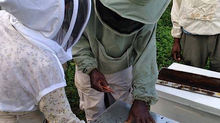Flow Hive:Some Considerations
- Laura Bee
- Feb 22, 2015
- 6 min read
By Laura Bee Ferguson

Recently a new hive invention called the Flow Hive has captured many people’s attention. I am receiving several Facebook and personal messages a day about asking what I think about this new-fangled natural honey collection system.
I have watched the marketing video, checked out the Facebook Page and examined the Indigogo campaign offerings and spent the last several days watching friends and beekeepers around the world jump on this bandwagon and excitedly waggle-dance the discovery back to me.
After thinking and musing and many levels of considerations I have some serious questions that I feel should be put into the concept and culture around such a design.
First I must say this: the marketing campaign itself fits my ethos to a “T”. This is an intergenerational looking project with an ultra-natural vibe. From first glance, these are my people! Sad to say, once I started delving into their campaign I saw little notice made of a few issues that I feel are key when bee-keeping and honey-robbing.
Some of my questions about the design were answered in the indigogo campaign. I am not sure how this mechanical gizmo works exactly, and until I see one of these things with my own eyes I probably won’t fully understand, but I gather that the honey is squeezed through the center of the plastic double-walled comb construction. Apparently no wax is harmed in the pressing of this honey, answering my questions about basic clean-up because the comb is pre-made plastic all the way up to cappings. The bees fill the cells with nectar and cap per usual.
The best part about it is watching their little tongues dipping into the cell, but that is probably where my interest in this product ends.
1.Plastic
I was once a plastic foundation user and learned quite quickly that plastic foundation, though effective and easy for the beekeeper, has questionable effect on bee colonies. Bee made wax foundation provides a whole host of subtle qualities of the hive: it can be warmed, chewed through so the colony may move in-hive without breaking the cluster and also provides a sensitive dance-floor to communicate waggle dance, scent and vibration within the hive. As a truly natural bee-keeper I am always trying to view the hive from a bee-centric perspective. Once I understood that plastic was a non-breathable wall I can easily compare this to humans living and sleeping in train-cars; imagine the sound, ventilation, fumes etc. Add the potential factors of hormone disrupting plastic off-gassing and suffice it to say, I have a stack of hard plastic foundation mildewing in my bee shed.
Apparently these beekeepers have not gotten the memo about in-hive bee-centric wellness and although our sweet teachers the bees are adaptable (bless their zillion hearts) I doubt a single one of them would vote for this method over self-created comb.
2. Honey-Robbing
Honey-Robbing, in my perspective is something that should always be undertaken with great care. I, and many of my friends, do not rob honey until the new spring flow is underway. When I see the nectar coming in I simply pull frames that are from the previous season, marked by old wax cappings. True, we don’t get the fresh spring flavors, but we do know that the honey is truly hive surplus and
therefore not taking anything away from needed honey stores.
In addition, when I remove honey combs individually, I can be assured that the honey is ripened and fully capped and can also see if the foundation is fully ripened end to end and most importantly that there are enough stores available to the population who may need it in these climatically challenged times. Put this machine in the hands of greedy or uninformed beekeepers and we will see many populations of bees succumbing to starvation or in need of additional over-winter sugar feeds which studies are showing may unnecessarily disrupt bee gut health and immunity.
Issues of stinging have never come up in my honey-robbing because I simply lift a few frames, brush bees off with a feather and lay it in a basket covered with a towel. Few bees are ever killed and I am honestly rarely stung during this endeavor. I have an answer to bee-stings during honey rob: move slowly, take only during peak nectar flow (bees are more docile), use a feather to move bees and work in tandem with friends. Cost: nothing
3. No More Back Breaking Labor
The Flow Hive says that you don’t even have to open your box! No more back-breaking beekeeping! Really? I ALWAYS check on the health and size of the colony before a honey rob. This is an important part of beekeeping: know your colony! Since I only enter hives around three times/year (spring, right before our drought season/nectar death and late fall, and I always do so with friends and students, my back seems to be in great shape. In addition, working with bees is one of the greatest joys of my life. I don’t see the drawback in actually working with the bees. I have a better answer than the Flow Hive for strenuous labor: it’s called the Top Bar Hive. Cost: free scrap wood or pallets and nails.
4. Bee Behavior and honey-robbing
Open honey caps in an apiary incites robbing. This is why many people have a honey house to spin frames. I usually bring the ripe comb to my kitchen with closed windows and strain the honey by hand. The Flow Hive Indigogo page talks about having a lid on the harvesting container (prevents bees drowning) but this will not in any way fool the bees. They will smell that honey and undoubtedly set to robbing weak hives. Not just the hive with the honey extraction, any weaker or small colonies, nucleus hives and feral colonies. Beekeepers who are really in the “flow” with their bees can observe this which is why beekeepers throughout the ages have not harvested honey in their apiary. Ok, I know, not quite as romantic as “honey on tap” but a sensual, satisfying pursuit nonetheless.
5. Saving Money
The folks working this market angle say this product will save money since we don’t have to get a honey spinner. Sometimes a Bee-club will buy a honey spinner and will hold a harvest day. This is great fun, and an absolutely celebratory community bonding event. Not every beekeeper needs a honey spinner.
Let’s also consider hidden costs: plastic, manufacturing plant, gas to go to work and ship, shipping materials and this: beekeepers with multiple hives will need multiple of these plastic machines. These hive components cost over $300 each If they never break, never fail and never harm a bee and are never the catalyst of a honey-rob volume miscalculation, then you STILL have the equivalent price of a honey spinner that will most likely, if well-made ACTUALLY last a life time (because they are not plastic). It can also be used by many people, many times! Cut the honey caps off with a knife, spin and you have leftover premade honeycomb for the colony to re-fill, perfectly made by the bees themselves! This helps bees! Less work, reusing as nature intended!
In addition, people who actually need help with large quantities of honey harvesting, like commercial beekeepers, are also commonly not in a place to invest a minimum of $300 per colony, especially if one adds costs of potential failures within the system. I doubt that this will become a go-to product for commercial beekeepers.
For the hobby beekeeper, Crush and Strain is the cheapest way to go. Cost: muslin fabric, spatula and big multi-use enamel pot.
My Ultimate Waggle Dance about the Flow Hive
I want to be diplomatic for this family operation, I really do! They captured the cultural vibe that has made its way into my bee-ish heart. We love our bees! These people and their marketing team seem absolutely lovely! By the looks of things, they will get a fair run of business. Our beekeepers with extra cash love their gadgets! If someone gifted me one, I would definitely try it, and if this convinced me that it was all the things they say it is, then I would sell the #%* out of it! Convince me and I proselytize, its how I roll! But I intuitively feel the chances are pretty slim that I will get out my pompoms or pulpit any time soon. In fact their leading line is something along the lines of "Harvesting honey used to be a labor of love." Well, Flow Hivers, for some of us it still is.
To me, this is a gadget that is promising harmony with bees, but delivering another level of separation and risk instead.
From the Flow Hive people:
A critique of the Flow Hive from the Natural Beekeeping Trust:
ACCEPTING REGISTRAION FOR 2016 Study Session!
#flowhive #naturalbeekeeping #templeofthemelissae #pathofthemelissae #beepriestess #beecentricbeekeeping #honeyrobbing #honeyharvesting #activism #apiculture #beecentricbeekeeping #beegoddess #beehistory #beescience #beekeeping #beesinwinter #ccd #cobbuilding #communitybuilding #earthfriendly #ecoalchemy #ecofriendly #familyfarms #forage #gardening #greenmovement #hivesinwinter #insulatinghives #landscape #landscaping #nongmo #organic #permaculture #pesticidefree #photo #pollinatorpathways #recycling #sacredbeekeeper #sacredbeekeeping #skep #symbols #text #video #winterbeekeeping #winterhiveobservation




































Comments